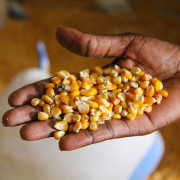Share your Seeds - a Solution to Biodiversity Loss
The Problem:
In 2009, Johan Rockström, the executive director of the Stockholm Resilience Centre, together with a group of experts identified a set of 9 planetary boundaries within which humanity can continue to develop and thrive for the generations to come, including amongst others climate change, ocean acidification and biodiversity loss. Biodiversity loss especially poses a global threat: 75% of agricultural diversity disappeared since the beginning of the 20th century. One of the reason for this is the development of monoculture and the loss of genetic diversity. But genetic diversity is crucial, without it seeds cannot resist to changing weather conditions and parasites. The lack of crops biodiversity can also lead to food security problems.
With the development of biotechnologies, intellectual property right over seeds came into being, in order to pay for the investments made in research and development.
First of all, to understand this issue it is important to understand the differences between three types of seeds.
The Heirloom seeds can be tracked in the past. They reproduce naturally through pollination, without any brutal modification. They are exactly the same plants that their parent plant. These varieties can be reproduced and preserved season after season in a natural way.
The hybrid seeds are created artificially, they have been « bred » and grown specifically to aid in their production and resistance to disease. They are made by breeding two different plants together to get a third variety. These hybrids only produce non fertile seeds.
Then the CMS (cytoplasm male sterility seeds) hybrids are even less fertile: they do not produce pollen, and so are unable to reproduce themselves. This has the same effect than a patent providing totally the reproduction of a species.
Because of the hybrid varieties small farmers who produce hybrids varieties are at the mercy of big companies, because it is forbidden to keep the seeds in order to cultivate them the following year, they have to buy new ones every season. The agribusiness has a monopoly of the seeds: 58% of the global market of seed varieties are patented and belong to the 4 leaders in the industry.
It is also important to say that the hybrid variety usually need more pesticides and fertilizers than the Heirloom, those products being sold by the same companies providing the hybrids.
What is done ?
The open source seed initiative (OSSI) is a community on the campus of the university of Wisconsin. Their starting point is the idea that genetic resources and seeds should be protected commons, free for humanity to use in any way it sees fit. The community developed a « free seed » pledge, that is printed on every seed packet they exchange or send to other people. This pledge states that the seeds contained in the packet can be « freely used, sold, bred and shared, and cannot be legally restricted in any case ». This way they want to make sure that at least, the genes in some seeds can never be locked away from use by intellectual property rights. This initiative was taken in response to the increased patenting of seeds worldwide, and was inspired by the open-source software movement.
Another great initiative takes place in France, at La Bourdaisière. There you can find the tomato conservatory where 650 different varieties of tomatoes are cultivated. The founder of this garden, Louis Albert de Broglie wanted to allow the public to watch, learn and understand the importance of biodiversity and to pass those varieties to the future generations. A yearly festival is also organised, where people can visit the gardens.
What can you do ?
The Hawaiian initiative “Eating in public” allows everyone to build a sharing seed station. They provide free plans of the stations, then you just have to put seed in used envelops repurposed into seed-packets, to put a stamp on the envelop, to write down the name of the seeds and any additional notes, to staple the envelop and it is ready to be shared.
The stations they provide on the island of Hawaii are entirely build with scraps and repurposed materials. They are launched with a starter kit of recycled envelops, stamp, staple and 50 seeds packets. Then it requires almost no-maintenance, people just need to replace the envelops, sharpen the pencils and send photos of the stations to “Eat in Public”.
The initiative provides stations for free in Hawaii, but for people outside of the island “Eat in Public” offers DIYs: the plans of the stations can be downloaded freely from their website.
The stations are designed to be placed on locations with lots of traffic and used by diverse populations. The favoured spots are amongst other: community centres, libraries, churches, coffee shops and so on.
To go further: useful Links:
- http://www.nomoola.com/seeds/diy.html
- http://www.labourdaisiere.com/jardin/fr/les-jardins/le-conservatoire-de-la-tomate
- http://www.opensourceseedinitiative.org/
Bildnachweis:
World Bank Photo Collection: https://www.flickr.com/photos/worldbank/14982575134/


